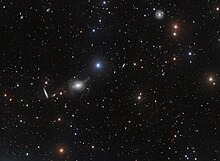astro.wikisort.org - Galaxy
NGC 5018 is an elliptical galaxy located in the constellation of Virgo at an approximate distance of 132.51 Mly. NGC 5018 was discovered in 1788 by William Herschel.
| NGC 5018 | |
|---|---|
 NGC 5018 taken by ESO's Very Large Telescope.[1] | |
| Observation data (J2000[2] epoch) | |
| Constellation | Virgo |
| Right ascension | 13h 13m 01.000s[2] |
| Declination | −19° 31′ 05.87″[2] |
| Redshift | 0.009413[2] |
| Helio radial velocity | 2809km/s[2] |
| Distance | 132.51 Mly |
| Apparent magnitude (B) | 11.71[2] |
| Characteristics | |
| Type | S...[2] |
| Other designations | |
| 6dFGS gJ131301.0-193106, ESO 576-10, ESO-LV 576-0100, GSC 06116-01096, IRAS 13103-1915, IRAS F13103-1915, ISOSS J13130-1931, LEDA 45908, 2MASX J13130099-1931058, MCG-03-34-017, PSCz Q13103-1915, SGC 131020-1915.3, UGCA 335, [CHM2007] HDC 772 J131300.99-1931058, [CHM2007] LDC 955 J131300.99-1931058, [FWB89] Galaxy 337, [M98c] 131020.0-191518, [SLK2004] 800[2] | |
One supernova, 2021fxy (mag. 13.9, type Ia), has been discovered in March 2021 in NGC 5018.
See also
- Galaxy
References
- "Elliptical elegance". eso.org. Retrieved 2018-08-09.
- "SIMBAD Astronomical Database - CDS (Strasbourg)". Results for NGC 5018. Retrieved 2018-08-09.
External links
 Media related to NGC 5018 at Wikimedia Commons
Media related to NGC 5018 at Wikimedia Commons
На других языках
[de] NGC 5018
NGC 5018 ist eine 10,7 mag helle elliptische Galaxie vom Hubble-Typ E3 im Sternbild Jungfrau auf der Ekliptik. Sie ist schätzungsweise 120 Millionen Lichtjahre von der Milchstraße entfernt und hat einen Durchmesser von etwa 130.000 Lj. Sie bildet zusammen mit NGC 5022 ein durch gravitativ gebundenes Galaxienpaar. Im selben Himmelsareal befindet sich u. a. die Galaxie NGC 5006.- [en] NGC 5018
[ru] NGC 5018
NGC 5018 (другие обозначения — ESO 576-10, MCG -3-34-17, UGCA 335, IRAS13103-1915, PGC 45908) — эллиптическая галактика (E3) в созвездии Дева.Текст в блоке "Читать" взят с сайта "Википедия" и доступен по лицензии Creative Commons Attribution-ShareAlike; в отдельных случаях могут действовать дополнительные условия.
Другой контент может иметь иную лицензию. Перед использованием материалов сайта WikiSort.org внимательно изучите правила лицензирования конкретных элементов наполнения сайта.
Другой контент может иметь иную лицензию. Перед использованием материалов сайта WikiSort.org внимательно изучите правила лицензирования конкретных элементов наполнения сайта.
2019-2025
WikiSort.org - проект по пересортировке и дополнению контента Википедии
WikiSort.org - проект по пересортировке и дополнению контента Википедии